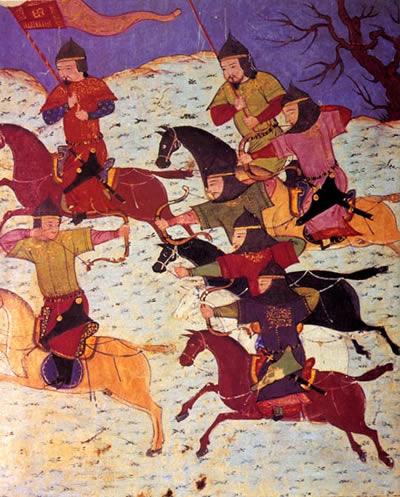By Curtis Wiemann
Among the cultures of the historical Mongol Empire which appear in various forms on Tarkir, the Mardu Horde – Sarkhan’s former clan, the RWB wedge commanded by Zurgo Helmsmasher – bears closest resemblance to the fabled Mongol horde. In war, the Mardu and Mongol armies alike share speed and ruthlessness as defining characteristics.
Armies on the March
Nearly everything from this clan, from their attire and weaponry down to the name “Mardu,” echoes its military Mongol counterpart. The term used by the Mongols for their encamped armies was “ordu,” describing both the warcamp and its leadership. Over time, this term came to be used in translation by chroniclers beyond the Mongol Empire, changing to take upon a very different meaning. The Mongol “ordu,” a disciplined army of elite warriors, organized by decimal ranks by the law of Chinggis Khan, became described as a disorganized, barbarian host – the infamous Mongol “horde”.

In war, the Mardu and Mongol armies alike share speed and ruthlessness as defining characteristics. The historical Mongol peoples shared with their Mardu counterparts a nomadic way of life which allowed for swift, relentless campaigns against immobile foes in China, Russia, and Persia. More than any other part of their identity, it could be argued that it was this shared heritage – of life in the saddle, of hunting by bow, of sleeping beneath the open sky rather than the walled cities of their rivals – that defined the Mongol peoples in the era of Chinggis Khan, and defined the Mardu in the words of Zurgo Helmsmasher. In their own records, the Mongols called themselves by two names under Chinggis’ reign: “the people of felt tents,” and “the nation of archers.”
“We live free under the wind, and freedom makes us strong.” – Zurgo, from Nomad Encampment flavor text.
The Way of the Bow
The card Kill Shot makes direct reference to the tremendous importance of the bow to the Mongol traditions of life and war. Martial practices like dakla existed in the fabled Mongol horde, honed by a lifetime spent hunting game for survival in the vast expanse of steppe [casthaven]scrubland[/casthaven] that included much of central and northern Asia. When adapted to war, Arrow Storm provides a direct view of the result.
The medieval Mongols and Mard are shown to be capable of close formation on horseback, riding forward as they volley fire into a distant foe. This mass archery, alongside the advantage of horseback mobility, fits Mongol and Mardu goals of speed and mobility, and made both forces conquerors against foes who lacked their capacity for mobility and range at war.
The Mongol ordu and Mardu horde share more than speed as a fundamental consideration in their culture and approach to war. The Edicts of Ilagra, defined in the Planeswalker’s Guide to Tarkir as a warrior’s code written down by the first khan of the Mardu and followed by their descendants, has a direct parallel in the history of the Mongols: the Great Yasaq of Chinggis Khan.[1]
The Laws of Ilagra and Chinggis Khan
The Yasaq (literally, “law” in the medieval dialect of Mongolian) remains elusive in its exact details, but as summarized by Muslim historians under Mongol rule in Persia, it included both literal commands and more philosophical reflections passed down from Chinggis Khan to his descendants, who would bear “the burden of thousands to be ruled.”[2] In many ways, it was a reflection upon the realities of nomadic life and rule, which are well summarized by the Edicts of Ilagra: “To conquer is to eat. To rule is to bleed. Victory or death.”
For the most part, the Mardu and Mongol armies only conquered as long as it served their immediate needs. They were accustomed to the cycles of movement and hunting which came naturally to nomadic life and which informed their armies’ triumph across the globe. Conquest brought wealth and glory, but long term immobile rule brought decay and a loss of the way of life that led them to triumph. In many senses it would be the truth of these laws from the first Khan of the Mardu that would spell doom for the historical Mongol Empire.
“To conquer is to eat. To rule is to bleed. Victory or death.” – The Edicts of Ilagra, from Planeswalker’s Guide to Tarkir, Part 2.
Total War
Ilagra’s final remark, “victory or death,” paints an accurate picture of the ruthlessness commonplace to medieval Mongol and Mardu warfare. For the Mongols of Chinggis’ era, war was total and unrelenting, and no ploy which preserved Mongol lives in service of victory could be taboo. The Mongol armies would willingly feign retreat and humiliation to goad foes into unwise assaults, or use captive enemy warriors as the first wave against entrenched cities, or annihilate defiant populations as a lesson to their fellows. The Mongols rewarded personal heroism, commended skill, and exalted selfless sacrifice just as do the Mardu, all to achieve victory with the army intact. If the horde stalled at the gates of a city or lost to an army in the field, all its advances and success would be lost – foes who would otherwise surrender in fear without a fight, like Russian Muscovy and much of Persia and northern China, would be emboldened to resist, wasting further Mongol lives in battle. To prevail, the Mongol and Mardu hordes alike needed to be swift, decisive, and utterly ruthless – tactics that served them well in battle and conquest, whether inspired by necessity or the example of the dragons of Tarkir.
Curtis Wiemann has two degrees in History, plays only Enchantress in Legacy, and is exactly as fun as those facts would make him sound.
[1] http://magic.wizards.com/en/articles/archive/planeswalkers-guide-khans-tarkir-part-2-2014-09-10
[2] Paul Kahn, ed., The Secret History of the Mongols (San Francisco: North Point Press, 1984), 185.

